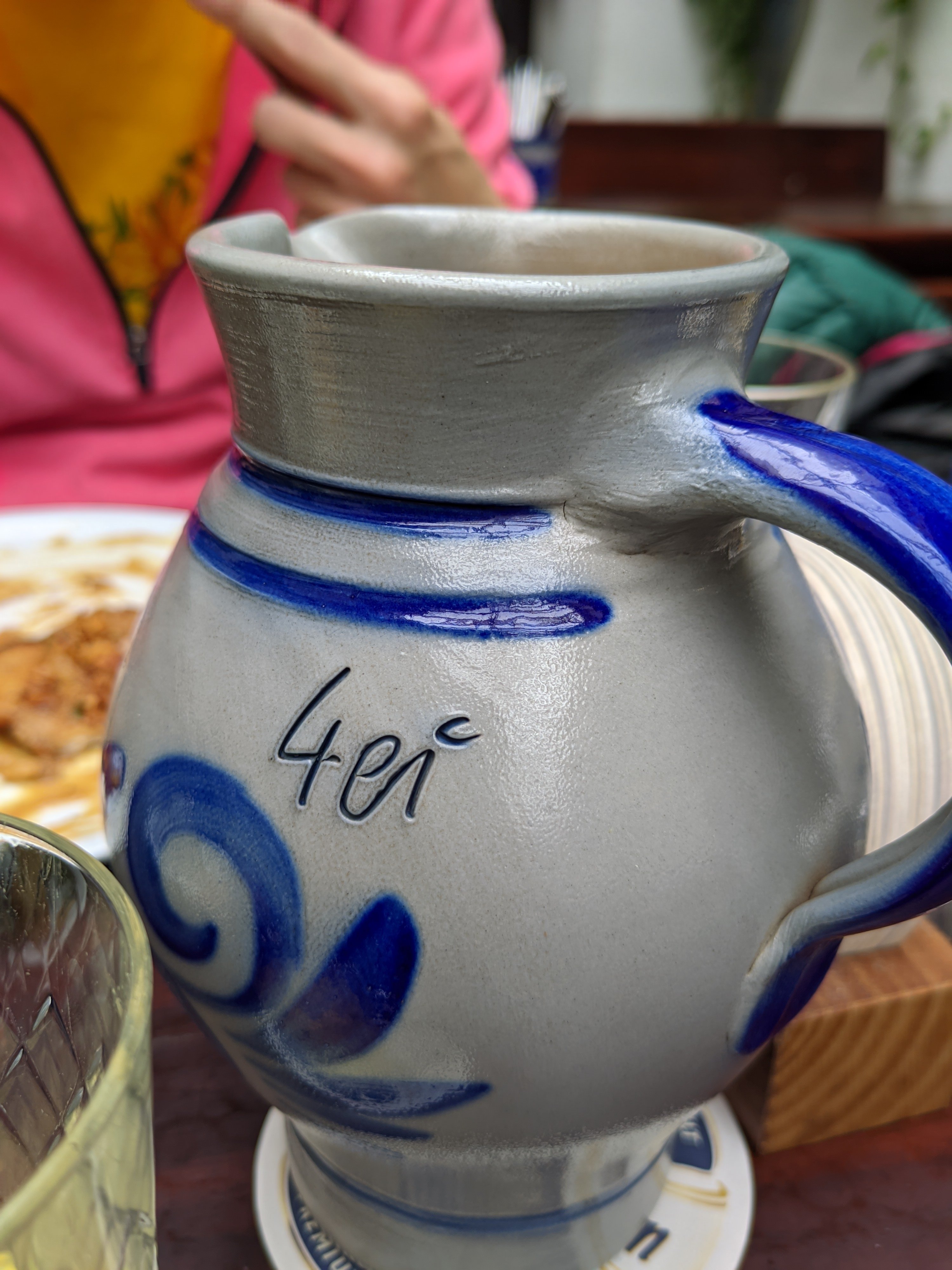For all of us Aeropress junkies, here’s a deep rabbit hole: https://aeroprecipe.com/. I hope y’all have as much fun as I did playing around with the recipes and results options.
Well. Didn’t know that existed. Thanks!
Best lightweight coffee maker. The rubber goes after a time but you can buy replacements
I’ve kept the rubber plunger out of the tube when in storage. When kept inside the tube it compresses the rubber and retains the shape memory which causes it to fail. Haven’t ever replaced mine and it is eight years old. Still works perfectly.
My original one i had to do this but the one i have now, if you fully depress the plunger with no coffee in it it comes out the bottom just enough to not squeeze the sides.
That rocks!
Just push the piston all the way in, and the rubber clicks when it comes out the other end of the cylinder. This way you can store it in a compact package.
Mine does not do this.
Interesting. I’m using the AP Go, so maybe the normal one doesn’t extend all the way through.
Edit: just checked how my normal AP works. It’s basically the same as the AP Go, but I guess this is a fairly new model, so there may have been some changes.
Are you using an older version?
Yes, it is eight years old.
It seems that the older models had a problem that was fixed. So, the tip needs to be tweakws a bit.
If you have an older model, store the pieces separately in order to prevent the rubber from being under constant compression. If you have a newer model, push the piston all the way in until the end of the piston pops out the other end. Oh, and that is only possible if the cap isn’t screwed on. That piece needs to be stored separately anyway.
Yes, the existing comments already allude to these problems/solutions.
Great tip! Thank you 🙌
Really? I have mine since probably 6 or 7 years and it’s still fine and I use it several times a week.
Mine died after 9 years or so. Did that thing where the rubber breaks down and gets super sticky and oily. Never had an issue with it losing its shape - you just have to make sure you store it fully pressed in so the lip pops out the far side of the tube
I’ve found you can extend the life of the plunger by placing the plunger rubber-side down on a table or counter top, tilting it slightly onto the edge of the rubber and then rotating it. This essentially presses the rubber and extends it outwards and seems to help achieve the seal you expect. I’ve been doing it for a while now and it’s worked well for me.
I’m sure it won’t last forever but it’s something worth trying to get a bit more life out of it.
I have one that’s about eleven years old now. Still works perfectly.
Coffee oils keep rubber moist 👍
Is that plastic? Gonna be a hard no for me Dawg
They’re working on a glass-and-metal premium version. But it’ll cost a premium price, though.
That would be amazing. The device is cool, and seemed to work well from the reviews, but the plastic prevented me from buying it.
It’s made of polypropylene, partially recycled, extremely durable, and again fully recyclable if it does reach end of life at some point. It’s also certified BPA free - as opposed to the very first version (that was transparent and used a different plastic). BPA doesn’t leech into water unless exposed over a very long time anyway, and the average brew time is about 3-5 minutes; but it’s good they made the change anyway. If I remember correctly, BPA became an issue mostly due to being in baby toys that are chewed on, or bottles for beverages with a very long shelf life (e.g. water, that practically lasts forever) where it can leech out over time.
To me it’s the ideal travel brewer, since I can pre-grind my coffee and keep it in a tin box, where I can also put a stack of filter papers in to keep them from getting wet. Glass just wouldn’t work on the road, the risk of damage is simply too high. And you’ll anyway need to have a plastic plunger, or at the very least a plastic coated one, since you need to have a 100% tight seal.
At home I don’t use it often since I have a decent espresso machine, but I can see the merit as a daily driver in a small kitchen.
Edit: Oh btw, if the body was made of glass, I can totally see how it would shatter someday while applying force. You have to push with quite a bit of power the water through.
The amount of plastics that actually get recycled is about 1% worldwide, according to the Gulf Petrochemicals and Chemicals Association (GPCA) https://www.sciencedirect.com/science/article/pii/S2214785321075969
The amount of Polypropylene that comes out of recycling is less than 1% of that 1% https://circularityinaction.com/2020PlasticRecyclingData
Unless you believe the stats from astroturf orgs like “The Recycling Partnership” that is funded by: The American Chemistry Council (i.e. the plastics manufacturers association), major producers of plastic packaging like Coke, PepsiCo, Uniliver, 3M, etc https://recyclingpartnership.org/funding-partners/
At this rate I’m not sure they’ll release it this year
Probably no worse than most drip coffee makers. Do you use a french press?
No I use a stainless moka pot. I don’t like to have hot things in plastic even if it’s bpa free. I don’t trust the companies to actually guarantee the entire supply chain
Questions: what are the perks to using this vs a pour over system (which is what I currently use when I’m out of cold brew)? Is this easy to use if you have limited hand dexterity and strength?
The effect on extraction by the slight pressurization (and ability to change the pressure by how hard you press) and speed of use would be two advantages over pour over.
It doesn’t require hand dexterity or, really, hand strength. Arguably a proper, well-made pour-over with a goose neck kettle takes more hand dexterity than an Aeropress. Basically you put the hot water in, wait, and then press the plunger. Body weight or mild strength is all it takes. I usually just put my hands on top and then lean with my body; that functionally makes it require no hand strength at all.
They’re very affordable, so perhaps worth trying. Unless you are concerned about microplastics. The entire thing is plastic.
Edit: they have a newer, more expensive version made of Tritan crystal. I know nothing about the composition of Tritan crystal and whether there is anything that can leech or whatever from it, but I would assume it gets rid of the microplastic concern. Though I’m not sure what the “rubber” stopper is made from.
Honestly I’d rather use plastic than have to press my hand down on heated glass. It’s bound to explode one day and send glass down your wrist.
Yes, that’s a fair point. Though, there are other materials that might be explored (types of metal perhaps?) for those that would prefer a non-plastic version.
The reason some might be concerned is that when “food-grade” plastics, like the polypropylene used by aeropress, are used and “exposed to hot water, they release trillions of nanoparticles per liter into the water.”
The slight pressurization and the friction of the rubber plunger likely amplifies that result.
Aeropress is more forgiving and produces more body. Pour over, being a percolation brew, will have higher extraction at the cost of being a bit more sensitive to technique.
Haven’t done a lot of pour over coffee, so my ideas might be inaccurate in that regard. I still use a moka pot from time to time, and have experimented with that enough to compare these methods to some extent. However, the AeroPress is my main method of choice.
control
Based on what I’ve observed, I think the key feature of an AeroPress is control. You can use any grind size, any extraction time, and any temperature below boiling. None of these variables are tied to one another in any way. With other methods, they are tied, so you will find yourself using one variable to control another, which isn’t ideal.
grind size and extraction time
With a pour over, you have to make the grind size big enough, or your paper will clog up. Clogged up paper will result in a long extraction time, which might not be what you want, so in a pour over you are essentially using grind size to put some limits to the extraction time. You can use coarse grind and pour very slowly to have more control over the result, but you can’t use fine grind and expect to have the same amount of control. Besides, pouring extremely slowly isn’t for everyone. With the AP, fine grind isn’t a problem, because you’ll be using the piston to push the water through the paper. Even if the paper is totally clogged up, because you used super fine Turkish grind, you can just push the water through anyway.
yield
Pour over method is still worth considering, because it allows you to irrigate the grinds with fresh water all the time, which maintains a high rate of extraction. However, you can also push that too far, which will result in bitter coffee. With the AP, it’s harder to screw up like that, because the grinds are constantly in contact with the water. Once enough has been extracted to the water, extraction rate will naturally slow down. That makes AP a more forgiving method. However, if you really want to maximize yield, pour over might be better for you.
temperature
Pour over and AP allow you to use whatever temperature you prefer, but the moka pot doesn’t. When the water is hot enough to produce steam, the pressure will begin to push the water through the grinds. High temperatures like that are good for efficient extraction, but they are also dangerously close to producing bitter coffee. It’s very easy to screw it up with the moka pot, whereas pour over and AP are far more forgiving in this regard.
strong coffee
I have never tried to make extra strong coffee with the pour over method, so I don’t really know how well that would work out. The moka pot and AP are really good at making strong coffee, although they can also be used for making normal strength as well. In this regard, they are quite flexible.
number of drinkers
The AP and moka pot have volume limitations, whereas a pour over allows you to just pour more and continue extracting. The AP is also ideal for making one normal cup at a time, but it can also be used for making 3-4 cups of strong coffee. The same philosophy also applies to the moka pot. Ideally, you would load the basket full and fill the water reservoir to make several cups of strong coffee - that’s what it’s designed to do. However, you can use less grinds to make normal coffee for a smaller number of people. The AP also allows you to make tiny experimental batches. This is really good if you want to compare different types of coffee, but you don’t want to drink too many cups. With the inverted method, you can easily make 100 ml batches instead and compare those with each other.
I had used one for many years, it’s great for small amounts of coffee. If you need to make coffee for your significant other as well, it’s a pain. Recently moved back to a French press and I love it
That is indeed a drawback this has. On the other hand I don’t think a larger aeropress would make much sense either. This size is just perfect, but definitely for one cup.
There is indeed the xl variant for when the significant otter wants a cup as well, i think it changes ratios a bit but i cannot taste it
I love the Aeropress. I don’t know if I’ve ever been able to make a bad cup with it. It seems so forgiving, yet you can really dial in a recipe at the same time.
My baseline recipe is 20g of coffee ground on the Encore (18 for light, 16 for med, 10 for espresso) and 200 ml water just off boil. Mix inverted for 2 min, stirring 3 or 4 times. Add 150 ml hot water in cold weather or right from the tap in hot water.
The only other brewer I bother with now is the OXO pour over, which is a good hands off brewer that makes me a very satisfying and consistent cup without the involvement of the Aeropress. It makes what it makes though. I use the same 20g coffee ground at 16-18, unbleached filters, and all 350 ml of water at once. I typically get evenly brewed grounds, but if I’m feeling so inclined I’ll check it’s getting all the coffee evenly, but whether I touch it or not, I feel I get the same result, so it’s more piece of mind than taste that is affected.
Nice I need to try adding the extra water next time. I have a bad habit of brewing and walking away too long before I push the plunger.
I typically steep it 1.5-2 minutes, the gf likes it from 2-5 min, James’s testing I think was good up to 10 minutes without too much difference, and even in the Aeropress instructions I think it calls for like 30 seconds. I still feel all produce something drinkable.
It’s a great backup to have, that’s for sure. I drink mostly cold brew, but sometimes I run out and there are a few days before I brew more. Aeropress is a fantastic way to brew a quick cup.
Scientists found a way to make cold brew in a few hours just recently. It even passed every blind taste test, too. I forget the machine name, but it’s also commonly used to clean jewelry, as well as use in a lab, for like $60.
Edit: I went and found the old article, they used ultrasonic waves and it only took them 1-3 minutes depending on preference. Unfortunately after reading another article, it’s a modification they made to existing espresso machines. Their initial machine was around £15,000, and was overkill. Not sure how someone would be able to replicate at home. 🥲
Ultrasonic cleaner? It basically vibrates like a speaker at high frequency, and when in water it can be used to clean jewelry.
If you find it, post it!
It’s not really an inconvenience for me; I set it up, let it brew overnight; easy-peasy.
Ultrasound? I have one of those I use to clean all sorts of things. Never thought of using one for coffee, but I could see it really rendering the oils, even cold.
Ultrasound?
I’ve had the aeropress since the month they came out, and I absolutely love it.
I like to brew on a mocha pot, pour into my aeropress, and plunge into a cup. It filters the sediment out for a super clean taste.
I use an aeropress filter in my moka pot. Best cup of coffee without the sediment
I wonder how this would affect my Turkish coffee. I think a lot of it’s texture and flavor is because a lot of the powder is kind of dissolved filtering it out might be a bad idea.
I tried it with Turkish coffee. IMHO, it ruined it.
You can just put an aeropress filter above the grounds before you screw the top on your mokapot (assuming you don’t have one of the super size ones)
It seems popular. I am set for coffee gear at this time. Very happy with the V60 02 and the Clever Dripper.
What’s your recipe right now?
Nice picture btw.
Seems very much personal taste, that spans a wide range these days.
On suggestions from YouTube I tried 20+g coarse with low volume and temperature based on competition winning recipes and hated it. No body, thin and unsatisfying.
So I’m back to 12-15g medium, inverted, add some 90-95C water and stir out the fizz, then up to 180g water or so. Heavy repeated agitation early on, after maybe 60s uninvert for a gentle plunge. Usually dilute a little with some cold, drink black.
I checked the brew temp and full boil gives 96C in the press. I often do 200F 93C on the kettle for about 90 in the press. Sometimes I just boil and add a splash of cold.
My beans are medium roast - city+, no oiliness. I like pretty trad rich coffee and hate thin acidic tea like brews. Tea makes better tea than coffee does IMO. But I also hate acrid flat bitterness of dark roasts.
Using the inversion method too, most excellent.
I used to do inversion, but was swayed by James Hoffman’s taste experiments and concluding method.
There’s no real reason to do it that way, but it’s just kinda fun.
It’s the risk of knocking it over and making a huge fucking mess, it’s thrilling.
The hand burning when I splash some boiling water through the holes for the cap wakes me up faster than the coffee when it happens! 😅
A bit of risk/reward there, can’t do this method anymore since my cat has toppled it more than once. At least with the plunger in approach I have maybe a second or two to stop a mess from happening…
I live dangerously.
So what’s the benefit of an aero press over a French press? I’ve used the French press for years and I always see people loving aero press. I’m curious what the differences are.
Main difference is the fact that the aeropress uses a paper filter which filters out sediment and oils giving the coffee a “cleaner” taste. From my research before I bought it, I remember it also being slightly healthier because, again, you filter out those oils.
This changes alot though, because of the filter, the aeropress can take finer grounds than the french press. Also when you press, you press all the water through the grounds.
Yep
So if you pour French press through paper filter it’s same thing?
Not quite. I said that was the main difference, but if we go into details, the physics of the thing, it’s a bit more complicated. The guy who invented the aeropress, afaik, tried to make a handmade espresso replacement. He didn’t succeed, but the way the aeropress works is a hybrid of immersion, percolation and pressure brewer, whereas the french press is all about immersion and that it’s. It has the plunger, but that’s for filtering, nothing else.
If anything, I think the aeropress is closer to a moka pot than anything. But it’s its own thing, honestly.
Interesting. I don’t know if I’d ever describe the coffee I brew as oily or anything like that. I suppose I have to try this sometime.
Oh, no. It’s not oily. Just a bit thicker. Like espresso. That’s partly because of the oils that coffee has.
Looks like they’re made of plastic, for starters.
Aeropress brings out a lot more flavor imo. The process of making it is also kinda fun.
Maybe I’ll need to try something with it side by side .
People need to stop doing inversions. At some point you are going to spill it and now we have good valve based options its not even necessary to stop the tiny amount of dripping that occurs. Even before we had the several valve solutions the amount that actually dripped through was tiny and had no impact on the flavour of the cup of coffee since you could put the plunger in and create a slight negative pressure that kept the liquid in.
James Hoffman taste tested this and couldn’t tell the difference, he has a fantastic video on what is actually worth doing and what isn’t with the Aeropress and inversion isn’t.
Yeah, it’s great. I’ve dialed in the super fast brew and i love how easy it is to make great coffee that’s not scolding hot out of the brewer.
Check out the winner from 2009, that’s what I use and it’s pretty amazing. https://worldaeropresschampionship.com/pages/recipes
I use water that’s 175F and only 14gs of coffee, but otherwise it’s the same.
Here is the recipe to save a click:
Coffee: 19.5–20g Grind: Slightly coarser than filter grind Water: 200ml @ 75°C Brewer: Inverted Filter: Paper, soaked
Directions:
- Stir 4 times
- Stop stirring, secure the filter and turn at around 10 seconds (total contact time around 15 sec.)
- Press and serve
















